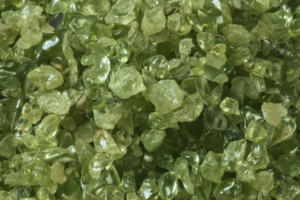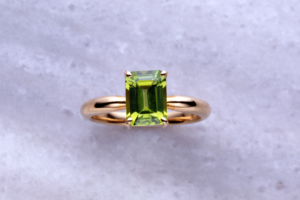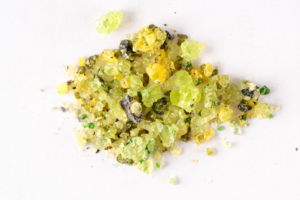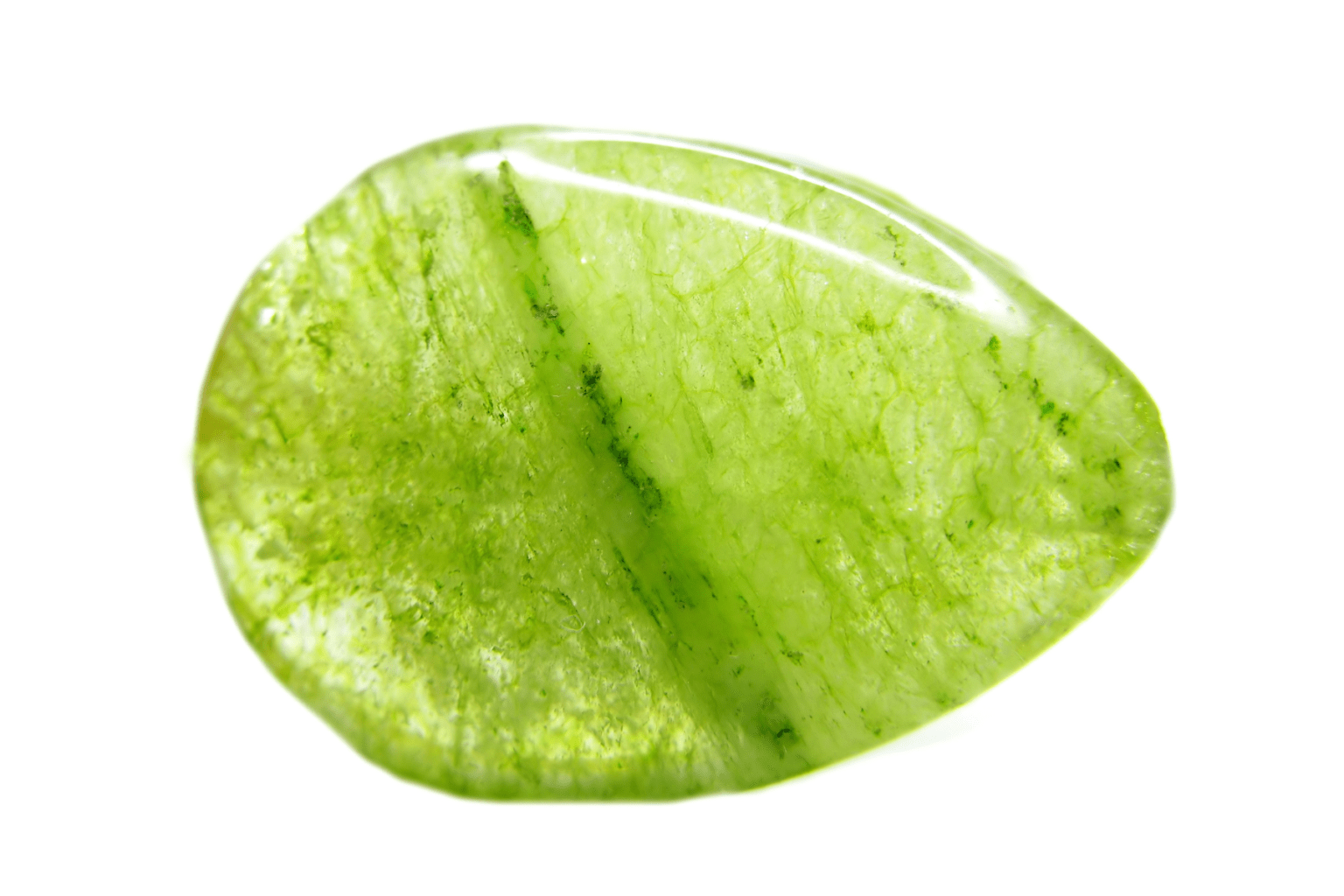Peridot is a gemstone that is a variety of the mineral olivine. It is a green-colored gemstone that is sometimes referred to as “evening emerald” because its green color can appear particularly vibrant under artificial light. The color of peridot can range from a yellowish-green to a deep olive green.
More About the Appearance of Peridot
Peridot is a gemstone that is typically yellowish-green to green in color, with shades ranging from a light, almost yellow-green to a deep, rich olive green. The intensity and hue of the color can vary depending on the location of the peridot’s origin, and the quality of the stone.
Peridot has a vitreous, or glass-like, luster and a transparent to translucent appearance. It has a relatively high refractive index, which gives it a bright and sparkling appearance.
Peridot is a relatively soft stone, with a Mohs hardness of 6.5 to 7, making it susceptible to scratches and abrasions. It is also a brittle stone, which means that it can be prone to breakage or chipping if handled roughly.
Overall, peridot is a beautiful and distinctive gemstone with a unique green color that makes it a popular choice for use in jewelry.
Is peridot a birthstone?
Yes, peridot is considered a birthstone for the month of August. In the modern birthstone system, peridot is the primary birthstone for August, along with sardonyx. Peridot is also considered a traditional birthstone for September in some cultures. Peridot’s bright green color is associated with the lushness of summertime, making it a popular choice for jewelry and gifts for those born in August.
Chakra
Peridot is associated with the solar plexus chakra, which is located in the upper abdomen and is associated with personal power, self-esteem, and confidence.
The solar plexus chakra is believed to govern the digestive system and is associated with the color yellow. When this chakra is balanced and aligned, it is said to promote feelings of self-confidence, inner strength, and vitality. It can also help individuals to set healthy boundaries and feel more in control of their lives.
Peridot is thought to be a powerful stone for working with the solar plexus chakra, as its green color is said to help balance and strengthen this energy center. It is also believed to promote clarity, positivity, and personal growth, making it a valuable tool for those seeking to improve their overall sense of self-worth and inner power.
The Shapes of Peridot

Peridot can be cut into a wide variety of shapes, depending on the desired use and the natural shape and size of the rough stone. Some of the most common shapes for peridot include:
- Round: Round peridot stones are popular for use in earrings and as accent stones in rings and necklaces.
- Oval: Oval-shaped peridot stones are versatile and can be used in a variety of jewelry designs, from simple stud earrings to elaborate pendant necklaces.
- Pear: Pear-shaped peridot stones have a distinctive teardrop shape and are often used in earrings, necklaces, and pendants.
- Cushion: Cushion-shaped peridot stones have a soft, rounded shape and are often used in engagement rings and other fine jewelry.
- Emerald cut: Peridot can also be cut into the elegant, rectangular shape of an emerald cut, which showcases the stone’s natural color and clarity.
- Cabochon: Cabochon-cut peridot stones have a smooth, rounded top and a flat base, and are often used in more casual, bohemian-style jewelry.
These are just a few examples of the many shapes in which peridot can be cut, and skilled gem cutters can create many other unique and beautiful cuts depending on the natural characteristics of the stone.
Peridot’s Energy
Peridot is believed to have a powerful and uplifting energy that can help to promote feelings of positivity, joy, and inner peace. It is associated with the solar plexus chakra and is believed to help balance and strengthen this energy center, promoting feelings of self-confidence, inner strength, and vitality.
In addition to its association with the solar plexus chakra, peridot is also believed to have a cleansing and purifying energy that can help to remove negative energy and emotions from the body and mind. It is thought to promote clarity and mental focus, making it a useful stone for those seeking to enhance their creativity, intuition, and spiritual awareness.
Overall, peridot is considered to be a stone of joy, growth, and positivity, and is believed to help the wearer cultivate a deeper connection to themselves and the world around them.
Cleansing your Peridot
Peridot can be cleansed using a variety of methods, depending on personal preference and the availability of materials. Some common ways to cleanse peridot include:
- Water: Peridot can be cleansed by holding it under running water for a few minutes. This can help to wash away any negative energy or buildup that may be present on the stone.
- Saltwater: Another way to cleanse peridot is to soak it in a bowl of saltwater for several hours. The saltwater helps to draw out any negative energy or impurities that may be present on the stone.
- Smudging: Peridot can also be cleansed by smudging it with sage, palo santo, or other cleansing herbs. Simply light the herbs and pass the peridot through the smoke, focusing on setting the intention to cleanse and purify the stone.
- Sunlight or Moonlight: Peridot can also be placed in direct sunlight or moonlight for several hours to help recharge and purify it. This method is especially effective during the full moon or on a sunny day.
- Sound: Peridot can also be cleansed using sound vibrations. This can be done by placing the stone near a singing bowl, tuning fork, or other sound instrument and allowing the vibrations to pass through the stone.
Ultimately, the method of cleansing peridot will depend on personal preference and what feels most effective for the individual. It is important to cleanse peridot regularly, especially if it is used frequently or in high-stress situations, to help maintain its positive energy and effects.
Taking Care of Peridot
Peridot is a relatively soft and delicate gemstone, so it is important to take care when cleaning and storing it to ensure its longevity and beauty. Here are some tips for taking care of peridot:
- Avoid exposure to heat: Peridot can be sensitive to heat, so it is important to avoid exposing it to high temperatures or sudden changes in temperature. This can cause the stone to crack or lose its luster.
- Clean with care: When cleaning peridot, avoid harsh chemicals or ultrasonic cleaners that can damage the stone. Instead, use a soft, damp cloth or a mild soap and water solution to gently clean the stone.
- Store carefully: When not in use, peridot should be stored in a soft cloth or a lined jewelry box to protect it from scratches and other damage. It is also important to store peridot away from other jewelry or objects that may scratch or damage it.
- Avoid exposure to chemicals: Peridot can be damaged by exposure to harsh chemicals, such as bleach, ammonia, or other cleaning products. It is important to remove peridot jewelry before cleaning or working with these chemicals to avoid damage.
- Regularly check settings: If peridot is set in jewelry, it is important to regularly check the setting to ensure that the stone is secure and not at risk of falling out or becoming damaged.
By taking these simple steps to care for peridot, you can help to ensure that it remains beautiful and vibrant for years to come.
 The History of Peridot
The History of Peridot
Here are some key points about the history of peridot:
- Ancient Egypt: Peridot was known to the ancient Egyptians as the “gem of the sun” and was believed to have protective properties. It was often used in jewelry and was also used to adorn the sarcophagus of Queen Cleopatra.
- Ancient Rome: The Romans valued peridot for its healing properties, and it was often used to treat liver and digestive problems. It was also used in jewelry, and many Roman emperors wore peridot rings as a symbol of their power and status.
- Middle Ages: During the Middle Ages, peridot was believed to protect the wearer from evil spirits and nightmares. It was also thought to bring good luck and fortune to the wearer.
- Renaissance: In the Renaissance period, peridot was highly valued by royalty and was often used in crown jewels and other ceremonial jewelry. It was also a popular choice for use in religious artwork and was often used to adorn altars and other sacred objects.
- Modern Times: Today, peridot is still highly valued as a gemstone, and it is often used in contemporary jewelry designs. It is also believed to have various spiritual and healing properties, and many people use peridot as a tool for promoting positive energy and inner growth.
Overall, the history of peridot is rich and varied, with many cultures valuing this gemstone for its beauty and healing properties throughout the centuries.
Summary
Peridot has a rich and varied history that dates back thousands of years. Ancient Egyptians referred to peridot as the “gem of the sun” and used it in jewelry, while the Romans valued it for its healing properties. During the Middle Ages, peridot was believed to protect the wearer from evil spirits and bring good luck. In the Renaissance, it was highly valued by royalty and used in crown jewels and religious artwork. Today, peridot remains highly valued as a gemstone and is believed to have various spiritual and healing properties. Throughout history, peridot has been prized for its beauty and positive energy, and it continues to be a popular choice for jewelry and spiritual practices today.

